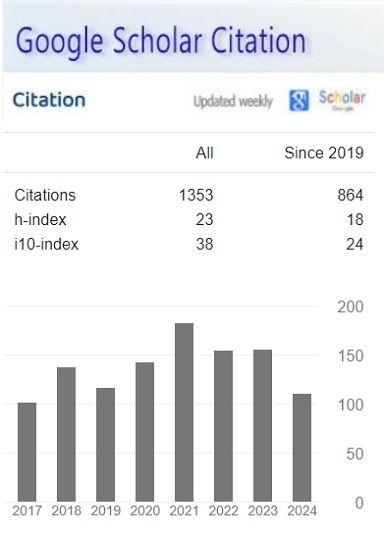Improving Sustainable Pedestrian Facilities in Congested Urban Areas Adapting Breeam Assessment: A Case of Dhaka, Bangladesh
Keywords:
Abstract
The persistence of the paper is to learn the role of walkable roads in the sustainable development of Dhaka City. Accordingly, a documented investigation through effective sources has been employed to demonstrate this study. The outcomes prove that walking can lead to sustainable urban growth from various aspects. Also, Pedestrian Facilities –which are the focal background of walking- act as focal arguments of growth in Dhaka city and have a great influence on adjusting and motivating their breeam assessment. Today due to the land kerb, lots of thick urban areas are facing pressures and difficulties, such as traffic jamming and lack of public open space. This study emphasizes finding means to condense pedestrian delay. This work presents a real scenario for sustainable pedestrian facilities through breeam assessment and offers comfortability in Urban Areas.
References
Accident Research Institute (ARI), 2012, “Road Safety Facts 2012”, Research Report, Bangladesh University of Engineering and Technology, Dhaka. [online] Available at: www.ijsei.com/papers/ijsei-55816-18.pdf [Accessed 07 Jan. 2018].
Bangladesh Bureau of Statistics, 2011, Population Projection of Bangladesh, 2011-2061, [online] Available at http://www.bbs.gov.bd/WebTestApplication/userfiles/Image/PopMonographs/PopulationProjection.pdf [Accessed 2 Jan. 2018]
Barua, U., Tay, R., Hoque, M. and Mamun, M., 2007. Analysis of pedestrian safety on five major arterial roads in Dhaka, Bangladesh. In Canadian Transportation Research Forum.
BREEAM. 2012. BREEAM Communities-Technical Manual Version SD202, Issue1.0. BRE Global Ltd, Hertfordshire.
BREEAM. 2013. BREEAM International New Construction-Technical Manual, Version SD5075. BRE Global Ltd, Hertfordshire.
Directorate-General for Environment (DGE), European Commission [2004] Reclaiming city streets for people Chaos or quality of life? [Online] Available at: http://ec.europa.eu/environment/pubs/pdf/streets_people.pdf [Accessed 07 Jan. 2018].
Habib M.A., Ahmed M. And Siddiquee, M. Z. H., 2005, ‘Transportation Problems and System Deficiencies of Dhaka City an Integrated Approach for Solutions’, BURP thesis, Department of Urban and Regional Planning (URP), BUET, Dhaka, Bangladesh.
Harvey, D., 1996. Cities or Urbanization? City, 1(1-2), pp.38-61. DOI: https://doi.org/10.1080/13604819608900022
Hossain A, 2014, Dhaka not pedestrian friendly, The Daily Prothom Alo, Viewed 2 January 2018. From http://en.prothomalo.com/bangladesh/news/56565/Dhaka-not-pedestrian-friendly.
Lawson D. and Smith J. (2013) Transport Strategy for Cambridge and South Cambridgeshire. [online] Available at: https://www.cambridge.gov.uk/sites/default/files/documents/2013 07 13 FECRA countycouncilpresentation v0.pdf [Accessed 07 Jan. 2018].
Mahmud, S.M.S., Hoque, M.S. and Bashir, G.M.M., 2008, ‘Deficiencies of Existing Road Network in Dhaka Metropolitan City’, CODATU-XIII International Conference on Sustainable Development Challenges in Transport in Cities of the Developing World: Doing what Works, Session 4A, 12-14 November, Ho-Chi-Minh City, Vietnam.
North West Bicester (2014) NW Bicester Masterplan: Vision and Objectives. [online] Available at: http://www.ecobicester.org.uk/cms/sites/ecobicester/files/folder/ecoBicester/20140321_NW Bicester Masterplan Vision and Objectives-Pt1.pdf [Accessed 02 Jan. 2018].
Rahaman, K. R. (2006) Design and Safety of Pedestrian Facilities in Dhaka City, Bangladesh. [online] Available at: http://www.ut.t.u-tokyo.ac.jp/research/2005/01khan.pdf [Accessed 03 Jan. 2018].
Rajuk, 2015, Dhaka Structure Plan 2015-2035 (DSP 2016-2035), available at http://www.rajukdhaka.gov.bd/rajuk/image/slideshow/1.%20Draft%20Dhaka%20Structure%20Plan%20Report%202016-2035(Full%20%20Volume).pdf [Accessed 2 Jan. 2018]
Roughton, C., Hengel, D.V., Duncan, A., Weigand, L. (2012). Creating walkable + bikeable communities: A user guide to developing pedestrian and bicycle master plans. [Online] Available at: ppms.trec.pdx.edu/media/.../IBPI%20Master%20Plan%20Handbook%20FINAL.pdf [accessed 6 January 2018)
Shafiqul M. M. and Masud K. M., 2001, “Current State of the Mobility of the Urban Dwellers in Greater Dhaka,” Proceedings of 94th Annual Conference of Air and Waste Management Association, June 24-28, Orlando, Florida, USA.
The Economist Intelligence Unit, 2017, The Global Liveability Report 2017, A free overview, [online] Available at: http://www.smh.com.au/cqstatic/gxx1l4/LiveabilityReport2017.pdf [Accessed 2 Jan. 2018]
Traffic Engineering Council Committee TENC-5A-5, Chair Charles V. Zegeer , 1998, Design and safety of pedestrian facilities: A recommended practice of the Institute of Transportation Engineers. [online] Available at https://safety.fhwa.dot.gov/ped_bike/docs/designsafety.pdf [Accessed 05 Jan. 2018]
Downloads
Published
How to Cite
Issue
Section
License
Copyright (c) 2020 Asian Journal of Applied Science and Engineering

This work is licensed under a Creative Commons Attribution-NonCommercial 4.0 International License.








